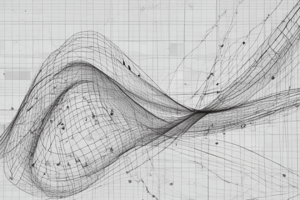Podcast
Questions and Answers
What is the primary purpose of adding polynomial terms in polynomial regression?
What is the primary purpose of adding polynomial terms in polynomial regression?
- To eliminate heteroscedasticity
- To increase the number of predictors
- To simplify the relationship between variables
- To account for non-linear relationships (correct)
Which method begins with no variables in a model and tests each variable as it is added?
Which method begins with no variables in a model and tests each variable as it is added?
- Forward selection (correct)
- Backward elimination
- Stepwise regression
- Bidirectional elimination
How does regularization assist in regression analysis?
How does regularization assist in regression analysis?
- It increases the complexity of the model
- It measures the effect of removed variables
- It allows for more predictors without penalty
- It shrinks the estimated coefficients towards zero (correct)
What is a characteristic of stepwise regression?
What is a characteristic of stepwise regression?
What is a common strategy to prevent overfitting in regression models?
What is a common strategy to prevent overfitting in regression models?
What is a key characteristic of Lasso Regression?
What is a key characteristic of Lasso Regression?
Which method combines penalties from both Lasso and Ridge techniques?
Which method combines penalties from both Lasso and Ridge techniques?
How does Ridge Regression differ from Lasso Regression?
How does Ridge Regression differ from Lasso Regression?
What is the primary goal of applying regularization techniques in regression models?
What is the primary goal of applying regularization techniques in regression models?
Which statement accurately describes a benefit of using Elastic Net over Lasso?
Which statement accurately describes a benefit of using Elastic Net over Lasso?
Flashcards are hidden until you start studying
Study Notes
Heteroscedasticity
- Heteroscedasticity, or heteroskedasticity, occurs in datasets with a vast range between maximum and minimum observed values.
Polynomial Regression
- Polynomial regression is a form of linear regression tailored for non-linear relationships between dependent and independent variables.
- The model can be represented as: y = a0 + a1x1 + a2x1² + … + anx1ⁿ.
- Choosing the degree of the polynomial is a hyperparameter that must be selected carefully to avoid model overfitting.
Overcoming Overfitting
- Model Complexity Reduction: Simplifying the model can help mitigate overfitting.
- Stepwise Regression:
- An iterative method of model building that adds/removes explanatory variables based on statistical significance.
- Forward Selection: Begins with no variables, subsequently tests each variable as it is included.
- Backward Elimination: Starts with all variables, removing one at a time based on statistical significance.
- Bidirectional Elimination: Combines forward and backward methods to determine which variables to include or exclude.
Regularization Techniques
- Regularization is used to limit or shrink estimated coefficients to avoid overfitting.
- It reduces validation loss and enhances model accuracy by penalizing high-variance models.
Types of Regularization
- Lasso Regularization (L1):
- Stands for Least Absolute Shrinkage and Selection Operator.
- Adds L1 penalty, which is the sum of the absolute values of beta coefficients.
- Ridge Regularization (L2):
- Applies L2 penalty, which is the sum of the squares of the beta coefficients' magnitudes.
- Elastic Net Regression:
- Combines penalties from both Lasso and Ridge.
- Rectifies Lasso’s limitations in high-dimensional data by allowing the inclusion of multiple variables until saturation.
- Handles groups of highly correlated variables effectively.
Clustering
- Clustering is an unsupervised learning method focused on identifying patterns in unlabeled input data.
- It categorizes data points into groups based on similarities.
Classification
- Classification involves grouping data based on characteristics and features, part of supervised learning.
- The model is trained using a dataset with features and corresponding labels, then tested on a separate dataset.
- Regression applies to continuous variables, while classification deals with discrete variables.
Bias vs Variance
- Bias:
- Refers to the difference between the average model prediction and the actual value.
- High bias indicates oversimplification, leading to underfitting.
- Variance:
- Measures the variability of model predictions for a given data point.
- High variance indicates the model's tendency to closely fit training data and potentially overfit.
Overfitting vs Underfitting
- Underfitting: Occurs when a model fails to capture underlying data patterns, characterized by high bias and low variance.
- Overfitting: Happens when a model learns noise along with the pattern, marked by low bias and high variance.
Bias-Variance Trade-off
- Achieving a balance between bias and variance is crucial to avoid both overfitting and underfitting, resulting in a well-generalized model.
Studying That Suits You
Use AI to generate personalized quizzes and flashcards to suit your learning preferences.




